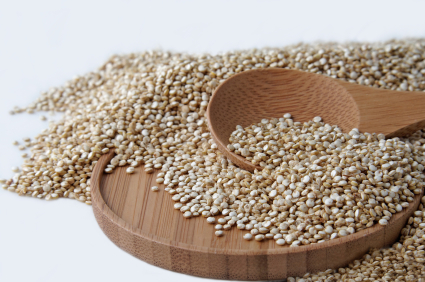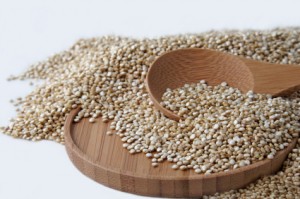 Don’t fill all of your storage containers with rice just yet – there’s a new grain in town.
Don’t fill all of your storage containers with rice just yet – there’s a new grain in town.
Quinoa (pronounced keen’-wah) is a high-protein grain that the Incas held sacred, calling it the “mother of all grains.” This ancient grain has had a recent resurgence in popularity because of its excellent nutritional profile, easy preparation and versatile nutty taste.
You will likely notice that quinoa is more expensive than rice, so you may be wondering, “Why is this stuff such a great addition to the prepper’s pantry?” For nutritional value, there is simply no comparison between what quinoa supplies versus other popular grains.
Technically a seed rather than a grain, quinoa is made up of 18% protein, supplying 8 grams per cup. It is a complete protein, supplying all necessary amino acids. The superfood is high in fiber, calcium, iron and phosphorus, as well as a good source of riboflavin, thiamine and niacin. It’s generally referred to as a grain because of the way it is prepared and used in the diet.
As a crop, quinoa is afforded instant protection from birds by its coating of bitter-tasting saponins. Most quinoa sold in North America has been processed to remove the saponins, but rinsing it well before cooking is still recommended.
Cooking quinoa couldn’t be simpler. After rinsing it under cold water, use the ratio of 3 cups of water to 1 cup of quinoa. (This will make 4 one-cup servings of the grain). Bring the water to a boil, and then reduce heat and cover, simmering for 15 minutes. The cooked germ looks like a small curl and the texture should be similar to al dente [1] pasta. When it’s finished cooking, simply fluff it with a fork and serve.
Quinoa is gluten-free. It is also sold in the form of a flour for gluten-free baking.
Another option for quinoa is sprouting. It has a quick germination period of only 4 hours, and sprouting enhances the vitamin content and activates the natural enzymes. Quinoa sprouts make a delicious fresh-tasting salad topping.
How can you serve quinoa? This versatile item can be used anywhere that you would use rice, pasta or barley. Try the following uses:
- As a pilaf, with nuts and dried fruit
- In soup
- As a breakfast grain with milk, brown sugar and cinnamon
- Seasoned with savory herbs and olive oil
- Topped with a stir-fry (instead of the usual nutritionless white rice)
- In any casserole calling for rice
- Mixed into things like chili or spaghetti sauce to “stretch” ground beef
To get you started with this versatile food, here are some quinoa recipes from my up-coming cookbook, The Prepper Cookbook.
Basic Quinoa
- 1 cup of quinoa
- 2 cups of water
Directions
The trick to delicious, lightly sweet quinoa is to wash it well to remove the bitter coating. The best method is to rinse it under running water until the water is clear, not frothy. Alternatively, if running water is unavailable, you can “swish” the quinoa in a large bowl of water and then drain it well. Use fresh water to cook the quinoa..
- In a saucepan, bring water to a boil.
- Add quinoa.
- Reduce heat and simmer for 15 minutes.
- Remove from heat and place the lid on the pot for 5 minutes.
Quinoa can be used any place that you would normally use rice or pasta – under sauces or stir fries, as a side dish or even as a hot breakfast cereal. It all depends how you season it.
Quinoa Pilaf
- 1 cup of quinoa
- 2 cups of water
- 2 cubes of MSG-free chicken or vegetable bouillon
- ¼ cup dehydrated carrots
- ¼ cup dehydrated bell peppers
- 2 tbsp dried minced onion
- ½ tsp oregano
- salt and pepper to taste
- ¼ cup of dried cranberries
Directions:
- In a medium saucepan, combine all ingredients except for cranberries.
- Bring to a boil, then reduce heat and simmer for 15 minutes.
- Remove from heat, stir in cranberries and place the lid on the pot for 5 minutes.
- Fluff with a fork before serving.
Quinoa Tabouli
This is a Middle Eastern salad made from pantry ingredients.
- 2 cups of prepared quinoa
- ½ cup of dried parsley
- ½ cup of scallions, if available, or 1 tsp of onion powder
- 1 tsp of garlic powder
- 1 tbsp dried mint
- ½ tsp basil
- ½ cup of lemon juice
- ¼ cup of olive oil
- salt and pepper to taste
Directions
- Place prepared quinoa in a bowl and stir in the other ingredients lightly until mixed.
- Cover the bowl and refrigerate for at least 12 hours to allow the flavors to meld.
- Serve cold.
Chocolate Quinoa Breakfast
- 1/4 cup quinoa
- 1/2 cup water
- 2 teaspoons cocoa powder
- 1/2 teaspoon pure vanilla extract
- honey or brown sugar to taste
Directions
- Combine quinoa, water, cocoa, and vanilla in a small saucepan with a lid.
- Bring to a boil.
- Reduce heat and simmer for 15 minutes.
- Remove from heat and place the lid on the pot for 5 minutes.
